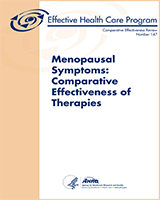NCBI Bookshelf. A service of the National Library of Medicine, National Institutes of Health.
Grant MD, Marbella A, Wang AT, et al. Menopausal Symptoms: Comparative Effectiveness of Therapies [Internet]. Rockville (MD): Agency for Healthcare Research and Quality (US); 2015 Mar. (Comparative Effectiveness Reviews, No. 147.)

Figure F-1
Vasomotor symptoms forest plot of pairwise comparisons—estrogen (high dose) compared with placebo.

Figure F-2
Vasomotor symptoms forest plot of pairwise comparisons—estrogen (standard dose) compared with placebo.

Figure F-3
Vasomotor symptoms forest plot of pairwise comparisons—estrogen (low/ultralow dose) compared with placebo.

Figure F-4
Vasomotor symptoms forest plot of pairwise comparisons—SSRIs or SNRIs compared with placebo.

Figure F-5
Vasomotor symptoms forest plot of pairwise comparisons—isoflavones compared with placebo.

Figure F-6
Vasomotor symptoms forest plot of pairwise comparisons—gabapentin compared with placebo.

Figure F-7
Vasomotor symptoms forest plot of pairwise comparisons—black cohosh compared with placebo.

Figure F-8
Vasomotor symptoms forest plot of pairwise comparisons—estrogen (high dose) compared with estrogen (standard dose).

Figure F-9
Vasomotor symptoms forest plot of pairwise comparisons—estrogen (high dose) compared with estrogen (low/ultralow dose).

Figure F-10
Vasomotor symptoms forest plot of pairwise comparisons—estrogen (standard dose) compared with estrogen (low/ultralow dose).

Figure F-11
Vasomotor symptoms forest plot of pairwise comparisons—ginseng compared with placebo.

Figure F-12
Plot showing consistency of closed loops with letters representing treatments. a: high dose estrogen; b: standard dose estrogen; c: low/ultralow dose estrogen; d: SSRI/SNRI; f: isoflavones; g: black cohosh; I: placebo.
Table F-1
Difference between network result and calculable pairwise effect estimates.
Table F-2
Network analysis including trials (n=134) specifying vasomotor symptoms as a primary outcome and requiring symptoms; SMD and 95% credible interval.
Table F-3
Rankings of comparative efficacy, standard deviations, and 95% credible intervals; trials (n=134) specifying vasomotor symptoms as a primary outcome and requiring symptoms.
Table F-4
Network analysis excluding trials judged to have included women without vasomotor symptoms (n=136); SMD and 95% credible interval.
Table F-5
Vasomotor symptoms rankings of comparative efficacy, standard deviations, and 95% credible intervals; excluding trials judged to have included women without vasomotor symptoms.
Table F-6
Network analysis excluding black cohosh trials (n=147); SMD and 95% credible interval.
Table F-7
Vasomotor symptoms rankings of comparative efficacy, standard deviations, and 95% credible intervals; excluding black cohosh trials.
Table F-8
Network analysis including trials rated good or fair quality (n=36); SMD and 95% credible interval.
Table F-9
Vasomotor symptoms rankings of comparative efficacy, standard deviations, and 95% credible intervals; including trials rated good or fair quality.
Table F-10
Network analysis restricted to trials examining moderate to severe hot flush reduction (n=55); SMD and 95% credible interval.
Table F-11
Vasomotor symptoms rankings of comparative efficacy, standard deviations, and 95% credible intervals; trials examining moderate to severe hot flush reduction.
Table F-12
Network analysis excluding large prevention-focused trials, SMD and 95% credible interval (n=150).
Table F-13
Vasomotor symptoms rankings of comparative efficacy, standard deviations, and 95% credible intervals; excluding large prevention-focused trials.
- Vasomotor Symptom Supplemental Tables and Plots - Menopausal Symptoms: Comparati...Vasomotor Symptom Supplemental Tables and Plots - Menopausal Symptoms: Comparative Effectiveness of Therapies
- Conserved Domain Links for Gene (Select 9324) (2)Conserved Domains
- PREDICTED: Homo sapiens gremlin 2, DAN family BMP antagonist (GREM2), transcript...PREDICTED: Homo sapiens gremlin 2, DAN family BMP antagonist (GREM2), transcript variant X2, mRNAgi|2217270018|ref|XM_047427839.1|Nucleotide
- Homo sapiens chromosome 4 open reading frame 36 (C4orf36), transcript variant 19...Homo sapiens chromosome 4 open reading frame 36 (C4orf36), transcript variant 19, non-coding RNAgi|2379217172|ref|NR_183021.1|Nucleotide
- BioProjects for Gene (Select 121466689) (4)BioProject
Your browsing activity is empty.
Activity recording is turned off.
See more...
